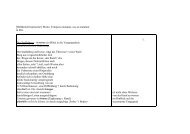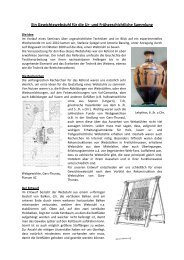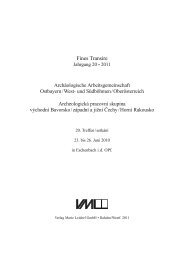Thorsten Uthmeier & Jürgen Richter
Thorsten Uthmeier & Jürgen Richter
Thorsten Uthmeier & Jürgen Richter
Create successful ePaper yourself
Turn your PDF publications into a flip-book with our unique Google optimized e-Paper software.
Chapter 14<br />
Transformation Analysis at Kabazi II, Levels VI/11-14<br />
Fig. 14-26 Kabazi II, Level VI/13, flow chart of the transformation of raw material units (continued from Fig. 14-25).<br />
scraper. Because they were not taken out of a reduction<br />
sequence, but retouched directly a�er collection<br />
from the Pleistocene surface, these two pieces most<br />
probably go back to human transportation, e.g. import<br />
to the site. When compared to the dimensions<br />
of flakes from workpieces, which were mainly discarded<br />
without being retouched, tools among single<br />
pieces point to size as the main criteria for the selection<br />
of blanks for modifications. The fact that frost<br />
cracks and patinated artefacts were used might be<br />
seen as a sign for a shortage of blanks of appropriate<br />
size and shape. This is in accordance with the fact<br />
that no special concept for the production of regular<br />
flakes was recognized.<br />
Together with a lateral sharpening flake (RMU<br />
11: Fig. 14-17, 3) and a single surface shaped tool<br />
in RMU 19 (Fig. 14-19, 1), again made from a large<br />
cortical flake, single pieces add the following characteristics<br />
to the assemblage of level VI/13: large flakes<br />
with straight lateral profiles, o�en partly covered by<br />
cortex on their dorsal surfaces, as well as a core made<br />
from a cortical flake, are the result of the reduction of<br />
simple cores. In some cases, the flaking did not start<br />
with a raw nodule or a roughly decorticated preform,<br />
but with a large cortical flake. This means that<br />
large nodules were, at least in some cases, broken or<br />
flaked into smaller portions before the reduction of<br />
cores began. Most probably, the corresponding cores<br />
or flakes of this reduction sequences were lost by natural<br />
site formation process. In addition, size seems to<br />
have been the most important criteria for the selection<br />
of blanks for use. Perhaps because no advanced concept<br />
or method of core reduction was applied, most<br />
blanks for tools were taken out of initial phases of the<br />
chaîne opératoire, when raw pieces were still covered<br />
by some cortex. In addition, there seems to have been<br />
a shortage of large flakes, indicated by collected frost<br />
cracks or patinated flakes. And, finally, Neanderthals<br />
of level VI/13 had the knowledge of rejuvenation by<br />
lateral sharpening flakes.<br />
249







